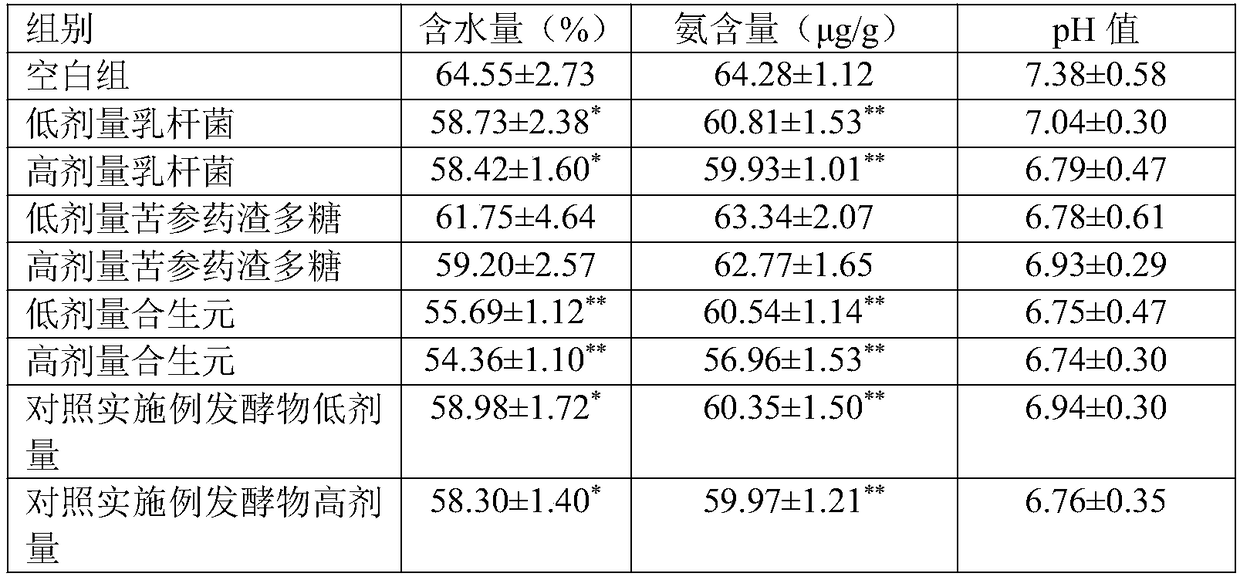Radix sophorae flavescentis residue polysaccharide synbiotics and preparation method and application thereof
A technology of synbiotics and medicinal residues, applied in the direction of bacteria, application, food science, etc. used in food preparation, can solve the problems of unseen and few synbiotics, and achieve the promotion of absorption, growth, and intestinal digestive enzyme activity. Effect
- Summary
- Abstract
- Description
- Claims
- Application Information
AI Technical Summary
Problems solved by technology
Method used
Image
Examples
Embodiment 1
[0032] The domestication of embodiment 1 plant lactobacillus
[0033] Lactobacillus plantarum was inoculated in the MRS medium containing 5g / L Sophora flavescens polysaccharide, cultured at 30°C for 24h, continuously passed for 5 generations, and then inoculated into the MRS medium containing 2g / L Sophora flavescens polysaccharide. After 24 hours, 3 generations were passed continuously to obtain Lactobacillus plantarum adapted to polysaccharides from Sophora flavescens, and stored in a refrigerator at 2-8°C for future use.
Embodiment 2
[0034] Example 2 Preparation of polysaccharide synbiotics from Sophora flavescens dregs
[0035](1) Adjust the pH value of the MRS medium with 1 mol / L NaOH to make the pH value 6.5, and then sterilize under high temperature and high pressure for 20 minutes. 100mL MRS liquid culture medium is packed in 250mL Erlenmeyer flask, add 0.2g Radix Sophorae Radix Polysaccharide V) Proportionally add petroleum ether for degreasing twice, dry the sample after degreasing, add 10 times the amount of 80% ethanol, reflux in a water bath at 80°C for 2 hours, filter while hot, and wash the filter residue with hot 80% ethanol for 2 to 3 times , after drying the filter residue, add 10 times the amount of pure water and heat to reflux at 150°C, extract twice, 2 hours each time, and combine the extracts. Concentrate the water extract under reduced pressure to an appropriate volume, and slowly add absolute ethanol to make the alcohol content reach 80%, stand overnight at 4°C, centrifuge to obtain ...
Embodiment 3
[0042] Embodiment 3 Below in conjunction with feeding test, biochemical detection test and microbiology test, the present invention will be further described:
[0043] 1. Animal feeding experiments
[0044] (1) Selection, grouping and experimental design of experimental animals
[0045] ICR mice (4 weeks old, male, 18-22g) were purchased from Qinglongshan Animal Farm in Nanjing. All animals were fed under SPF grade conditions at 22°C and a 12-hour day-night cycle, and were adapted to feeding after 1 week. Randomly divided into 8 rats in each group, gavaged once a day, and continued gavage for 28 days. Drugs tested: Lactobacillus plantarum, Sophora flavescens polysaccharide (prepared according to the method in Example 1), and Sophora flavescens polysaccharide synbiotic (prepared in Example 2, hereinafter referred to as synbiotic). Comparative examples. See Table 1 for specific groups of experimental animals and dosages.
[0046] Table 1 Experimental Animal Grouping and Admi...
PUM
 Login to View More
Login to View More Abstract
Description
Claims
Application Information
 Login to View More
Login to View More - R&D
- Intellectual Property
- Life Sciences
- Materials
- Tech Scout
- Unparalleled Data Quality
- Higher Quality Content
- 60% Fewer Hallucinations
Browse by: Latest US Patents, China's latest patents, Technical Efficacy Thesaurus, Application Domain, Technology Topic, Popular Technical Reports.
© 2025 PatSnap. All rights reserved.Legal|Privacy policy|Modern Slavery Act Transparency Statement|Sitemap|About US| Contact US: help@patsnap.com



